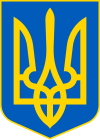
Back سياسة أوكرانيا Arabic Украинаның дәүләт ҡоролошо Bashkir Палітыка Украіны Byelorussian Политика и държавно устройство на Украйна Bulgarian ইউক্রেনের রাজনীতি Bengali/Bangla Politický systém Ukrajiny Czech Politisches System der Ukraine German Πολιτική της Ουκρανίας Greek Política de Ucrania Spanish Politique en Ukraine French
Politics of Ukraine | |
|---|---|
 Coat of arms of Ukraine | |
| Polity type | Unitary semi-presidential constitutional republic |
| Constitution | Constitution of Ukraine |
| Formation | 24 August 1991 (independence)28 June 1996 (constitution in force) |
| Legislative branch | |
| Name | Verkhovna Rada |
| Type | Unicameral |
| Meeting place | Verkhovna Rada Building, Kyiv |
| Executive branch | |
| Head of state | |
| Title | President |
| Currently | Volodymyr Zelenskyy |
| Appointer | Direct popular vote |
| Head of government | |
| Title | Prime Minister |
| Currently | Denys Shmyhal |
| Appointer | Verkhovna Rada |
| Cabinet | |
| Name | Government of Ukraine |
| Current cabinet | Shmyhal Government |
| Appointer | Verkhovna Rada |
| Ministries | 19 |
| Judicial branch | |
| Name | Judiciary of Ukraine |
| Constitutional Court | |
| Chief judge | Nataliya Shaptala |
| Seat | 14 Zhylianska St., Kyiv |
| Supreme Court | |
| Chief judge | Yaroslav Romanyuk |
 |
|---|
|
|
The politics of Ukraine take place in a framework of a semi-presidential republic and a multi-party system. A Cabinet of Ministers exercises executive power (jointly with the president until 1996). Legislative power is vested in Ukraine's parliament, the Verkhovna Rada (Ukrainian: Верховна Рада, lit. 'Supreme Council').
As part of the Soviet Union as the Ukrainian Soviet Socialist Republic until 1991, the political system featured a single-party socialist-republic framework characterized by the superior role of the Communist Party of Ukraine (CPU), the sole-governing party then permitted by the Ukrainian SSR's constitution. In 1996, the current constitution replaced the previous constitution that was introduced in 1978.
The widely condemned Russian annexations of Crimea in 2014, and of Donetsk and Luhansk in 2022 have complicated the de facto political situation associated with those areas.